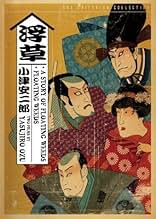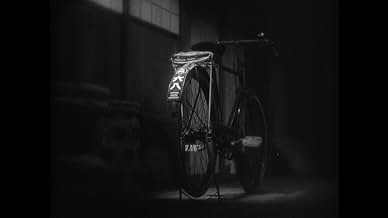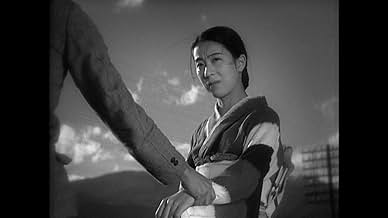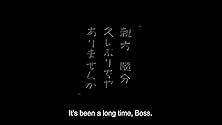NOTE IMDb
7,6/10
3,7 k
MA NOTE
La maîtresse d'un acteur kabuki manigance un complot pour tuer le fils de son amant.La maîtresse d'un acteur kabuki manigance un complot pour tuer le fils de son amant.La maîtresse d'un acteur kabuki manigance un complot pour tuer le fils de son amant.
- Réalisation
- Scénario
- Casting principal
- Récompenses
- 1 victoire au total
Kôji Mitsui
- Shinkichi
- (as Hideo Mitsui)
Emiko Yagumo
- Otaka
- (as Rieko Yagumo)
Chishû Ryû
- Shouting audience member
- (non crédité)
Avis à la une
Remakably similar in structure yet different in tonal effect to Ozu's more famous 1959 remake, this story of a travelling troupe's last days in a seaside village was one of Ozu's first forays into a quiet, rural background, though it still feels brisk compared to the more staid and sumptuous remake. The depictions of stage life are more slapstick-oriented than in the remake (most notably in Tokkan Kozo's hilarious turn in a full-sized dog costume), but are counterbalanced by sensitive portrayals of all the characters, especially the great, dignified lead performance by Takeshi Sakamoto. The romantic interludes are as powerful as in the remake, though without employing the overt sensuality of on-screen kissing; instead there appears to be the use of a filter or gauze to give the scenes between the young couple an otherworldly effect, which gives more emphasis of the idea of the actress employed to seduce the troupe leader's son enacting a "performance", an idea that I would have like to have seen developed even further. Even so, this is a marvellous work with a set of wonders distinguishable from that of the remake.
(1934) A Story Of Floating Weeds
SILENT DRAMA
Co-written and Directed by Yasujirô Ozu centering on a small traveling theater group going from village to village similar to what a circus does. The leader of this troupe is Kihachi (Takeshi Sakamoto) who happens to be stopping by at a village who once had an affair with an old flame who happens to also have a well groomed teenage son with goals to go to college and Kihachi who from the time he was young has always pose as his uncle and not as his biological dad since he travels a lot and is always absent. While hanging around, and as a result of spending a great deal of time with him as opposed to spending time with his current mistress he's been traveling with, this mistress becomes jealous and tries to sabotage this relationship by asking one of the young teenage girls in the troupe to make a play for him. It really takes about 45 minutes to get involved with the story since that is how long it takes for the viewers to fully understand it's characters and it's situations. Some of the more memorable moments are the little boy traveling with the theater troupe who at times doesn't look like he was acting but was improvising which he's character was almost absent in the 1959 colored talking version!
Co-written and Directed by Yasujirô Ozu centering on a small traveling theater group going from village to village similar to what a circus does. The leader of this troupe is Kihachi (Takeshi Sakamoto) who happens to be stopping by at a village who once had an affair with an old flame who happens to also have a well groomed teenage son with goals to go to college and Kihachi who from the time he was young has always pose as his uncle and not as his biological dad since he travels a lot and is always absent. While hanging around, and as a result of spending a great deal of time with him as opposed to spending time with his current mistress he's been traveling with, this mistress becomes jealous and tries to sabotage this relationship by asking one of the young teenage girls in the troupe to make a play for him. It really takes about 45 minutes to get involved with the story since that is how long it takes for the viewers to fully understand it's characters and it's situations. Some of the more memorable moments are the little boy traveling with the theater troupe who at times doesn't look like he was acting but was improvising which he's character was almost absent in the 1959 colored talking version!
Early silent film from acclaimed Japanese director Yasujiro Ozu, "A Story of Floating Weeds" is an ostensibly simple tale of the head of an itinerant troupe of Kabuki players reconnecting with his teenage son Shinkichi (Koji Mitsui). The boy, who had been told that his father was a civil servant who had died, is a student 'with prospects' and the father does not want him to know of his humble origins. As he says to one of the female players in his troupe "My son belongs to a better world than yours", which of course, is the same world as his. Although the focus of the story is on the 'master' and his secret family, there are a number of entertaining scenes featuring the troupe as they are stuck in the town with their performances rained out, broke and bored, which much of the gentle humour coming at the expense of Tomi-boh (Tomio Aoki), the little boy with the errant bladder who plays a dog in the troupe's show. I watched an English-subtitled Criterion Edition on TCM and my only criticism is that the piano score seemed (IMO) too 'Western' for the setting (but I have no idea what the original music was like). The film is a slow-moving but poignant and beautifully filmed taste of pre-WW2 Japanese life. Later audiences would have found Shinkichi's mother's statement that he'll soon be old enough for the draft much more foreboding than Ozu could have intended. Remade by the same director as "Floating Weeds" in 1959.
This is one of the earliest Ozu films widely available, and the Criterion version is outstanding in quality.
Its a perfect example of Ozu at his best. Its a gem of a film - beautifully shot, a perfect structure, funny, sad and fascinating. The story is simple enough - a traveling troupe arrive at a town, not realizing the reason the chief actor picked the town is because an old flame of his lives here with his son. His current girlfriend in her jealousy tries to stir things up, but things don't turn out as either expect.
What is most striking about the film is just how modern it seems. The characters are believable and funny, the female characters are strong and willful, while even the minor characters are nicely sketched out. The acting is nothing short of brilliant, which makes the whole film very entertaining - this is no period piece of academic interest only, its a great work of art and a wonderful film - a masterpiece really.
Its a perfect example of Ozu at his best. Its a gem of a film - beautifully shot, a perfect structure, funny, sad and fascinating. The story is simple enough - a traveling troupe arrive at a town, not realizing the reason the chief actor picked the town is because an old flame of his lives here with his son. His current girlfriend in her jealousy tries to stir things up, but things don't turn out as either expect.
What is most striking about the film is just how modern it seems. The characters are believable and funny, the female characters are strong and willful, while even the minor characters are nicely sketched out. The acting is nothing short of brilliant, which makes the whole film very entertaining - this is no period piece of academic interest only, its a great work of art and a wonderful film - a masterpiece really.
People float, their stories, the roles they perform and worlds they bring to life, this is the main thrust of the film.
So I have been recently surveying early Ozu as part of two personal quests: the first of these is where I'm looking for images of some purity from the first hours of cinema. The film is fine in this regard, Ozu's most renowned silent film about a kabuki actor returning with his troupe to his hometown to confront a difficult past. There is concentrated mind, a clear gaze. Composed shots, especially outdoors. But hardly any noticeable difference from his previous films. Why this is held in comparatively higher esteem than say Dragnet Girl or Passing Fancy, I posit has a lot to do with a more overt Japaneseness.
Earlier Ozus were distinctly modern: I Was Born But.. about schoolkids growing up in a rapidly Westernized Japan, Dragnet Girl about a young boxer drawn to the excitement of gangster life. Tokyo Woman unraveled like what was called a 'kammerspiel' in Weimar Germany. There was no benshi narrating these, as was the traditional norm adopted from Japanese theater. They employed the Western fashion of intertitles. Western garb for the leading players. References to movies, music records, boxing, corporate or factory work.
But this one has some of that exotic appeal that first fascinated the rest of the world about Japan. The same thing as the Mizoguchi revival in the 50's. For some reason, Western viewers are a lot more receptive to Japanese films that validate idealized preconceptions.
Now my other quest where this fits into, is films that visually or otherwise exemplify the karmic resonances that move our worlds. What kindles our emotional fires. In the best of cases, this means a storytelling part governed by a set of abstract parameters that control how we tell that story. How the world is in turn colored and appears to us. At around this time, in the West this was primarily being developed as film noir.
The Japanese are some of the most reliable to turn to for this: cultural seclusion cultivating purity, plus many actual practices for doing so - from gardening to making tea. The effort is to embody the world as it comes into being, this is the level that Western art has rarely managed to attain. It's worth getting to know about these things, if only to shatter those preconceptions. A tea ceremony is not about pomp or quaint etiquette but meditation.
So here we have a man who has abandoned his child and run off to play roles on a stage. Turns out he has become known for what is grouped together in kabuki as bandit plays, folk legends about heroic scoundrels. (a famous example of these that you have the chance to see adopted to film and from this era, is Kochiyama Soshun by Sadao Yamanaka).
Presumably this is how he views himself, a man who is wrong by conventional standards but deep inside pure.
Now and then he returns home, again playing a role. This early misdeed returns to haunt him: his son is seduced by a woman from his troupe, another actor performing a role. He learns the truth and in turn seems ready to run off. The whole thing replicates itself, recycling the same floating story. Only forgiveness can sever the destructive karma that has been set in motion.
Again this is fine and the film worth watching. What it's missing however, I believe is an additional layer that resolved ordinary drama on stage, conflating performance of the inner story with the one we are watching as our film about it. Transitory but precious humanity, rendered visually as a play passing through town. A lot of room for improvisation, as real life shapes the thing.
Imbalance that reflects impermanence is the key. Instead we get balanced drama.
If you have time and the resources and as example of what I'm talking about, I recommend that you look for a silent French film called Eldorado from '21, where a female dancer sublimates motherly woes into seductive dance. It is more primitive in some ways, but in others not.
So I have been recently surveying early Ozu as part of two personal quests: the first of these is where I'm looking for images of some purity from the first hours of cinema. The film is fine in this regard, Ozu's most renowned silent film about a kabuki actor returning with his troupe to his hometown to confront a difficult past. There is concentrated mind, a clear gaze. Composed shots, especially outdoors. But hardly any noticeable difference from his previous films. Why this is held in comparatively higher esteem than say Dragnet Girl or Passing Fancy, I posit has a lot to do with a more overt Japaneseness.
Earlier Ozus were distinctly modern: I Was Born But.. about schoolkids growing up in a rapidly Westernized Japan, Dragnet Girl about a young boxer drawn to the excitement of gangster life. Tokyo Woman unraveled like what was called a 'kammerspiel' in Weimar Germany. There was no benshi narrating these, as was the traditional norm adopted from Japanese theater. They employed the Western fashion of intertitles. Western garb for the leading players. References to movies, music records, boxing, corporate or factory work.
But this one has some of that exotic appeal that first fascinated the rest of the world about Japan. The same thing as the Mizoguchi revival in the 50's. For some reason, Western viewers are a lot more receptive to Japanese films that validate idealized preconceptions.
Now my other quest where this fits into, is films that visually or otherwise exemplify the karmic resonances that move our worlds. What kindles our emotional fires. In the best of cases, this means a storytelling part governed by a set of abstract parameters that control how we tell that story. How the world is in turn colored and appears to us. At around this time, in the West this was primarily being developed as film noir.
The Japanese are some of the most reliable to turn to for this: cultural seclusion cultivating purity, plus many actual practices for doing so - from gardening to making tea. The effort is to embody the world as it comes into being, this is the level that Western art has rarely managed to attain. It's worth getting to know about these things, if only to shatter those preconceptions. A tea ceremony is not about pomp or quaint etiquette but meditation.
So here we have a man who has abandoned his child and run off to play roles on a stage. Turns out he has become known for what is grouped together in kabuki as bandit plays, folk legends about heroic scoundrels. (a famous example of these that you have the chance to see adopted to film and from this era, is Kochiyama Soshun by Sadao Yamanaka).
Presumably this is how he views himself, a man who is wrong by conventional standards but deep inside pure.
Now and then he returns home, again playing a role. This early misdeed returns to haunt him: his son is seduced by a woman from his troupe, another actor performing a role. He learns the truth and in turn seems ready to run off. The whole thing replicates itself, recycling the same floating story. Only forgiveness can sever the destructive karma that has been set in motion.
Again this is fine and the film worth watching. What it's missing however, I believe is an additional layer that resolved ordinary drama on stage, conflating performance of the inner story with the one we are watching as our film about it. Transitory but precious humanity, rendered visually as a play passing through town. A lot of room for improvisation, as real life shapes the thing.
Imbalance that reflects impermanence is the key. Instead we get balanced drama.
If you have time and the resources and as example of what I'm talking about, I recommend that you look for a silent French film called Eldorado from '21, where a female dancer sublimates motherly woes into seductive dance. It is more primitive in some ways, but in others not.
Le saviez-vous
- AnecdotesA Moxa treatment refers to the burning of an herb called moxa (aka mugwort) on, or directly above, the skin. Recipients of the treatment generally didn't like the burning sensation on their skin, although this was supposed to enhance circulation and lymphatic flow. Also, the scent of moxa is believed to have a soothing, relaxing effect, which would have been important to counteract the skin irritation.
- Citations
Kihachi: What did you plan to do with my son?
Otaka: Who cares about your son? He's cheap, like you, playing around with actresses.
[Kihachi beats Otaka]
Otaka: Are you sorry? I hope you'll be very sorry. The world is like a lottery. You take your ups and your downs. Let's make up please. That makes us even, you see. Just think how I feel.
- Crédits fousThe film title and credits are placed before a backdrop of plain sackcloth. This would become a trademark of Yasujirô Ozu films.
Meilleurs choix
Connectez-vous pour évaluer et suivre la liste de favoris afin de recevoir des recommandations personnalisées
- How long is A Story of Floating Weeds?Alimenté par Alexa
Détails
- Date de sortie
- Pays d’origine
- Langues
- Aussi connu sous le nom de
- Histoire d'herbes flottantes
- Société de production
- Voir plus de crédits d'entreprise sur IMDbPro
- Durée1 heure 26 minutes
- Couleur
- Mixage
- Rapport de forme
- 1.37 : 1
Contribuer à cette page
Suggérer une modification ou ajouter du contenu manquant

Lacune principale
By what name was Histoire d'un acteur ambulant (1934) officially released in India in English?
Répondre























